The Shift from CAD to AI-Driven Design
For decades, design engineers relied on traditional CAD tools to manually create and iterate part models. While precise, this process was labor-intensive, linear, and often detached from real-world manufacturability constraints. Iterating on complex geometries meant redesigning from scratch or reworking layers of embedded features. When scaled to hundreds or thousands of SKUs, this approach becomes unsustainable.
Generative AI upends this model by introducing an algorithmic co-pilot into the design process. It allows engineers to input design parameters—such as load requirements, material types, cost ceilings, and manufacturing methods—and generates multiple geometry options optimized for those constraints. What once took weeks of iteration can now be completed in hours.
How Generative AI Works in Manufacturing Design
At its core, generative design leverages artificial intelligence, machine learning (ML), and computational geometry to produce design solutions. These systems use a feedback loop, incorporating design intent, physics simulations (like FEA), manufacturing constraints, and performance metrics to iteratively evolve design outputs. The result is not a single design but a set of manufacturable solutions ranked by efficiency, strength-to-weight ratios, material consumption, or other production KPIs.
Unlike parametric modeling, where a user defines the design geometry, generative AI allows the machine to explore possibilities humans may never conceive, especially useful for topology optimization and material-efficient forms.
Integration with On-Demand Manufacturing Platforms
The true value of generative AI is unlocked when it’s integrated directly into on-demand manufacturing ecosystems. Modern cloud-based platforms that offer CNC machining, injection molding, metal casting, or 3D printing services can now plug into AI-assisted design tools. This enables real-time design-for-manufacturing (DFM) feedback based on actual machine capabilities and factory constraints.
For instance, if a designer is creating a part intended for selective laser sintering (SLS), the AI can suggest optimal wall thicknesses, self-supporting geometries, and build orientations that reduce post-processing. If the same part were intended for aluminum die casting, the system would instead optimize for draft angles, parting lines, and thermal contraction properties. This adaptive intelligence, contextualized to specific manufacturing technologies, significantly reduces the risk of design failure or iteration loops after a prototype is produced.
Accelerating Time-to-Market with Design Automation
One of the biggest bottlenecks in product development has always been the prototyping phase. According to a 2024 report by Deloitte, the average design-to-prototype turnaround time in traditional industries still spans 4 to 6 weeks. With generative AI, manufacturers can cut this cycle by 40–60%. Companies like Airbus, Ford, and GE have already adopted AI-driven design workflows to accelerate the development of structural parts, brackets, turbine components, and even consumer interfaces.
For startups and SMEs in the on-demand manufacturing space, this means they no longer need large in-house design teams. By using generative tools integrated with cloud-based manufacturing platforms, they can go from napkin sketch to production-ready CAD in a fraction of the time, while adhering to material constraints, production methods, and cost thresholds.
Bridging the Gap Between Designers and Engineers
One subtle but profound impact of generative AI is how it democratizes design intelligence. Historically, there has been a disconnect between industrial designers, who focused on form and user experience, and manufacturing engineers, who prioritized function and feasibility. Generative AI becomes the bridge—an intelligent interpreter that translates aesthetic intentions into geometrically and mechanically valid models.
Moreover, AI can act as a “digital mentor” for junior engineers, flagging potential design flaws (like stress concentrations or manufacturability issues) and suggesting corrections based on learned best practices. This kind of embedded expertise is especially valuable in industries with skills gaps or high turnover.
Challenges: Interpretability, Control, and Over-Reliance
Despite its immense potential, generative AI is not without limitations. One major challenge is interpretability—designers often struggle to understand how or why the AI has proposed a certain geometry. Black-box outputs can create hesitation in highly regulated industries like aerospace, automotive, or medical devices, where traceability and design intent documentation are paramount.
Secondly, there is the issue of control. While AI can generate hundreds of iterations, not all of them may align with a company’s brand, aesthetic, or functional expectations. Designers must still steer the AI and apply human judgment—a role that cannot be outsourced entirely to machines.
Finally, over-reliance on AI without verifying outputs through simulations or physical prototyping can result in production failures. Most mature workflows use generative design as a starting point, followed by simulation, verification, and sometimes manual refinement.
Real-World Applications in Generative Design
Let’s consider a real-world use case from the consumer electronics industry. A manufacturer developing a compact housing for a wearable device needed a design that minimized material use while retaining drop-resistance and thermal ventilation. Using generative AI, the team defined constraints including internal PCB layout, target dimensions, impact resistance, material (ABS), and injection molding as the manufacturing method.
Within 90 minutes, the AI generated 12 viable design alternatives with built-in snap fits, optimized ribbing, and minimized support requirements for molding. Two versions were prototyped via 3D printing for functional testing and refined with minor tweaks before full-scale tooling. The entire cycle—from concept to tool-ready design—was completed in less than two weeks, compared to the usual 6–8 weeks.
The Road Ahead: Merging AI, CAM, and MES Systems
As we look to the next horizon, the integration of generative AI with CAM (Computer-Aided Manufacturing) and MES (Manufacturing Execution Systems) will create truly intelligent factories. Imagine a scenario where a part is designed via AI, sent directly to CAM software for toolpath generation, and then scheduled into the MES based on available machine capacity, tooling, and raw material inventory. This would create a seamless, autonomous production loop driven by digital intelligence, paving the way for mass customization at scale.
NVIDIA’s Omniverse platform, Autodesk’s Fusion 360 with generative design extensions, and Siemens NX AI modules are already pushing the envelope in this direction.
Conclusion: Generative AI is Redefining Design-for-Manufacturing
In an industry built on precision, customization, and agility, generative AI offers an unprecedented advantage. It not only accelerates design but elevates it, bringing together geometry, functionality, manufacturability, and cost-efficiency in one loop. For on-demand manufacturers, the ability to transform vague concepts into validated, ready-to-produce designs within hours is no longer a competitive edge—it’s becoming a baseline expectation.
Companies that embed generative design early in their development lifecycle are better positioned to innovate, scale, and respond to customer demands without being bottlenecked by outdated design practices. The future isn’t just digital—it’s intelligently generative.
Mechkonnect Industrial Solutions integrates cutting-edge design automation, AI-augmented engineering workflows, and rapid prototyping capabilities to help you bring your ideas to life efficiently, accurately, and at scale.




